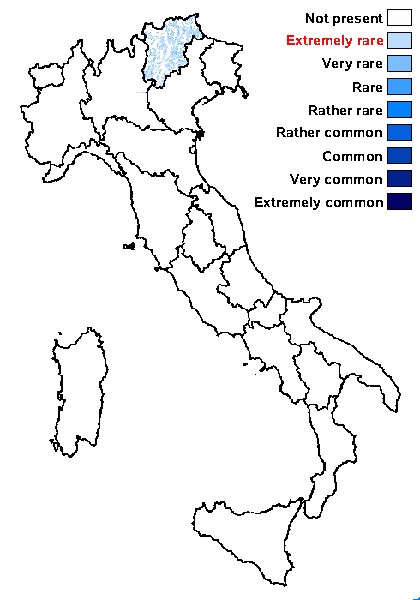Gyalideopsis helvetica van den Boom & Vězda
Öst. Z. Pilzk., 9: 28, 2000.
Synonyms:
Distribution: N - TAA (Nascimbene & al. 2021).
Description: Thallus crustose, episubstratic, thin and membranous, smooth, greyish green, slightly glossy, subgelatinous when wet, sorediate, the soralia scattered, excavate, c. 0.15 mm across. Apothecia biatorine, 0.3-0.4 mm across, mostly adnate, but sometimes sessile and constricted at base, scattered or clustered, with a flat to convex, reddish brown, epruinose disc. Proper exciple of loosely anastomosing hyphae embedded in a gelatinous matrix; hymenium colourless, 60-65 µm high, K/I+ yellowish brown; paraphyses branched and anastomosing, c. 1.5 µm thick, not widened at apices; hypothecium colourless. Asci 4(-8)-spored, cylindrical-clavate, thin-walled, apically thickened, the wall I-, the contents K/I+ reddish. Ascospores submuriform, with 5 transverse and 0-2 longitudinal septa, constricted at septa, narrowly ellipsoid to fusiform, 18-22 x 4.5-7 µm. Photobiont chlorococcoid. Spot tests: K-, C-, KC-, P-, UV-. Chemistry: without lichen substances. Note: a species with a smooth, green-grey, glossy thallus and scattered excavate soralia, apothecia (when present) reddish-brown, with submuriform, fusiform ascospores in mostly 4-spored asci; it grows on fallen, decorticated tree trunks; widely distributed in the Holarctic region but altogether rare. The Italian sample was collected by G. Thor on a stump in the Stelvio National Park, in a subalpine, open Larix-stand.
Growth form: Crustose
Substrata: lignum
Photobiont: green algae other than Trentepohlia
Reproductive strategy: mainly asexual, by soredia, or soredia-like structures (e.g. blastidia)
Commonnes-rarity: (info)
Alpine belt: absent
Subalpine belt: very rare
Oromediterranean belt: absent
Montane belt: extremely rare
Submediterranean belt: absent
Padanian area: absent
Humid submediterranean belt: absent
Humid mediterranean belt: absent
Dry mediterranean belt: absent

Predictive model
Growth form: Crustose
Substrata: lignum
Photobiont: green algae other than Trentepohlia
Reproductive strategy: mainly asexual, by soredia, or soredia-like structures (e.g. blastidia)
Commonnes-rarity: (info)
Alpine belt: absent
Subalpine belt: very rare
Oromediterranean belt: absent
Montane belt: extremely rare
Submediterranean belt: absent
Padanian area: absent
Humid submediterranean belt: absent
Humid mediterranean belt: absent
Dry mediterranean belt: absent

Predictive model
 Index Fungorum
Index Fungorum
 GBIF
GBIF

